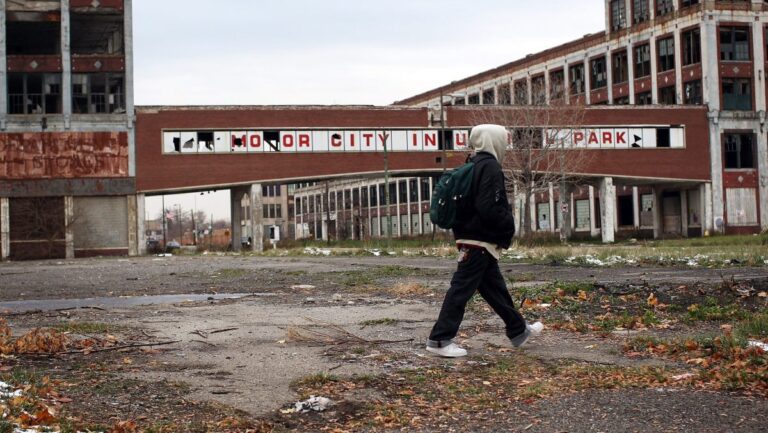For several months of the year, residents of wildfire-prone areas know they have to they expect poor air quality. They wear masks, stay indoors when it gets bad, and avoid inhaling smoke or fine particles as much as possible. But what if the air quality is always bad? Staying inside all day, every day, is simply not an option.
According reference by the nonprofit news organization Capital B, pollution is pervasive in industrial Midwestern cities, and the effects are felt even more acutely in majority black communities. Consequently, black families are leaving the area by the thousands.
Adam Mahoney is a national climate and environment reporter with Capital B. He joined Marketplace's Kimberly Adams to talk about the new Black migration to the South and what can be done to reverse the trend. An edited transcript of their conversation is below.
Kimberly Adams: So which Midwest cities did you focus on for this piece? And why?
Adam Mahoney: Earlier this year, I traveled across the Midwest to report on the exodus of Blacks from many of the largest, once industrial hubs in that region. So we focused on Chicago, Detroit. Gary, Indiana; except for St. Louis and Cleveland, Ohio.
Adams: Can you make for me the connection between these industrial hubs and pollution and what your story is about, which is immigration?
Mahoney: You know, as most people know, during the first Great Migrations, between 1910 and 1970, millions of Black people left the South for the Northern cities, for the Midwestern cities. And a lot of people settled in these growing industrial hubs, and a lot of those industries thrived on black labor, right? They were able to underpay black workers while, you know, black people were struggling under these kinds of treacherous working conditions. And the whole time that was happening, as we know now, these industrial plants were kind of destroying Black communities with pollution, either from, you know, air sources or water pollution, soil pollution. And as those industries slowly began to die, it left black communities kind of trapped—one, without economic security now, but also with this industrial pollution and the effects of that in terms of health outcomes. So what we found is that, in the Midwest, despite the fact that blacks make up only 10% of the population of the Midwest, they make up about a third of those who live in communities that are considered “disadvantaged” by environmental injustice, by pollution and contamination. So it's a big difference. A lot of these environmental damages and these health outcomes have kind of driven Black people out of these cities as people try to move away from these damages.
Adams: And where do people go?
Mahoney: Yes, it's a bit ironic. Right now, the South is the only region in the United States where more blacks have moved than since 2000. Many of these growth hubs are places like Atlanta [and] Charlotte, North Carolina. And I say it's ironic because as people leave the Midwest to escape these environmental damages, they're kind of running toward the epicenter of climate change. And many of these growing hubs are places that are constantly hit by climate disasters, not to mention have their own environmental damage and pollution there as well.
Adams: What are some of the long-term implications of this, especially for communities that are left behind?
Mahoney: I mean, we've already seen enough intense and deep crises. I can just use Gary, Indiana, as an example, which was a city literally built by and for industry. It was founded by US Steel Corp., which at the time was the largest company in the world. And since steel production went down and those jobs went away, that kind of created this huge hole where now Gary's been facing bankruptcy for over a decade, gun violence has gone up, poverty has gone up. So all these ills that mark a dispossessed community were born out of this very process of deindustrialization that was once driven by the migration of black peoples.
Adams: What do you think should happen? Especially, you know, when it comes to regulations around these things, to really make a difference? Or is this just a trend that will happen?
Mahoney: I think there are many factors at play. We live in yet another system, in terms of environmental regulations, where industry and capital somehow dictate progress in reducing pollution. I think at the end of the day, and what many activists and community organizers have shared with me, is that, really, the only way to guarantee safe and healthy communities is to not have these polluting industries. And that obviously has to do with our shift to renewable energy. But really, at the end of the day, that's what people are pushing for, is clean jobs in their neighborhoods and, you know, not being burdened by pollution at the end of the day.
There's a lot going on in the world. Through it all, Marketplace is here for you.
You rely on Marketplace to analyze what's happening in the world and tell you how it affects you in a fact-based, accessible way. We rely on your financial support to continue to make this possible.
Your donation today strengthens the independent journalism you rely on. For just $5/month, you can help keep Marketplace alive so we can keep reporting on the things that matter to you.

